Marrying Vega and Zen: The AMD Ryzen 5 2400G Review
by Ian Cutress on February 12, 2018 9:00 AM ESTBenchmarking Performance: CPU Legacy Tests
Our legacy tests represent benchmarks that were once at the height of their time. Some of these are industry standard synthetics, and we have data going back over 10 years. All of the data here has been rerun on Windows 10, and we plan to go back several generations of components to see how performance has evolved.
All of our benchmark results can also be found in our benchmark engine, Bench.
3D Particle Movement v1
3DPM is a self-penned benchmark, taking basic 3D movement algorithms used in Brownian Motion simulations and testing them for speed. High floating point performance, MHz and IPC wins in the single thread version, whereas the multithread version has to handle the threads and loves more cores. This is the original version, written in the style of a typical non-computer science student coding up an algorithm for their theoretical problem, and comes without any non-obvious optimizations not already performed by the compiler, such as false sharing.
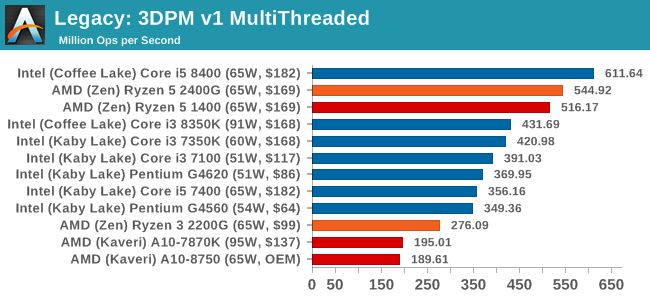
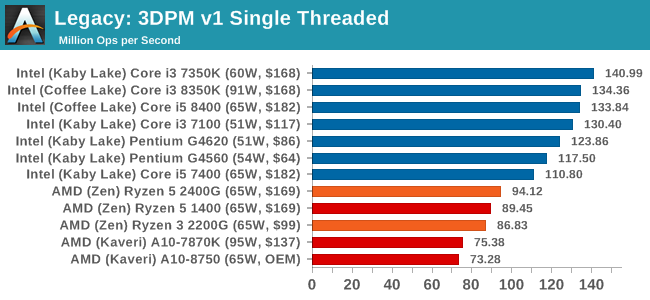
CineBench 11.5 and 10
Cinebench is a widely known benchmarking tool for measuring performance relative to MAXON's animation software Cinema 4D. Cinebench has been optimized over a decade and focuses on purely CPU horsepower, meaning if there is a discrepancy in pure throughput characteristics, Cinebench is likely to show that discrepancy. Arguably other software doesn't make use of all the tools available, so the real world relevance might purely be academic, but given our large database of data for Cinebench it seems difficult to ignore a small five minute test. We run the modern version 15 in this test, as well as the older 11.5 and 10 due to our back data.

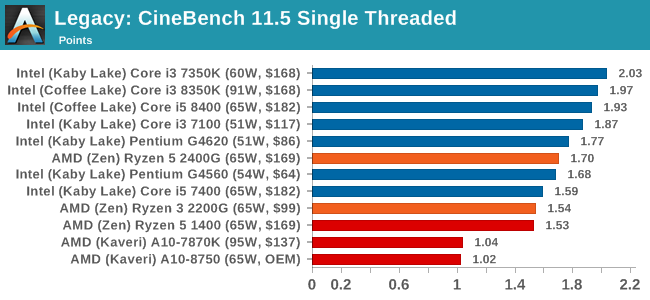
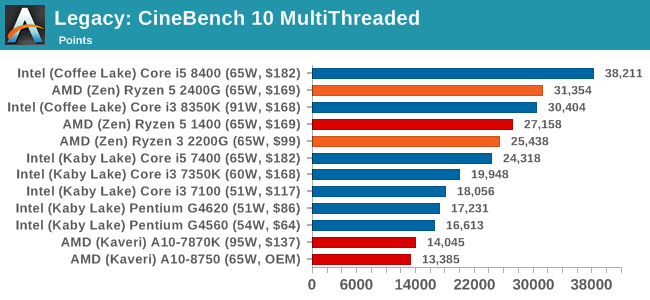
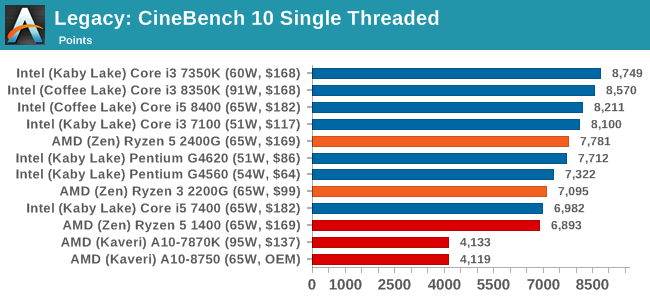
x264 HD 3.0
Similarly, the x264 HD 3.0 package we use here is also kept for historic regressional data. The latest version is 5.0.1, and encodes a 1080p video clip into a high quality x264 file. Version 3.0 only performs the same test on a 720p file, and in most circumstances the software performance hits its limit on high end processors, but still works well for mainstream and low-end. Also, this version only takes a few minutes, whereas the latest can take over 90 minutes to run.
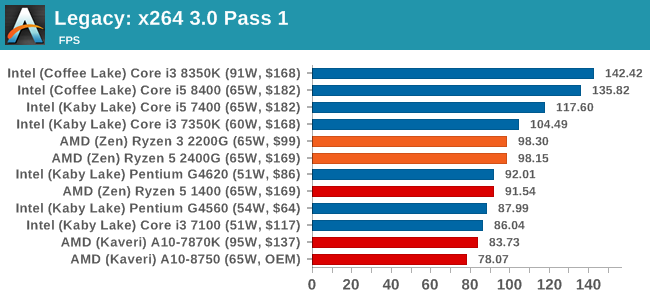
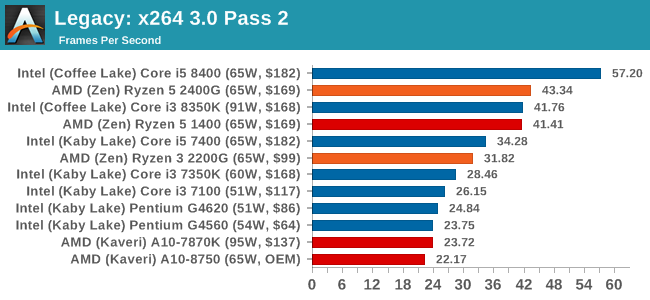










177 Comments
View All Comments
coolhardware - Monday, February 12, 2018 - link
I have been holding on to my Intel 2500K desktop for what seems like forever. It has been a trusty companion but with a TDP of 95W and a dedicated GPU pulling 100W+ I'm looking for something a little less power hungry. AMD seems to have what I've been looking for and the price is right :-)Amazon has the 2400G in stock, http://amzn.to/2BVzSSn and I think I'm going to bite the bullet!
PS does anybody have a mobo recommendation for pairing with the 2400G? (stability is my main concern, probably won't OC since the 2400G should be a nice step up from my 2500K)
zaza - Monday, February 12, 2018 - link
if already have a decent GPU it is better to get the Ryzen 1600 instead. it is only 10 or 20$ more but you will get two extra and 8 extra PCIe lanes. These APU only make sense as a placeholder to get something better, for example building a working PC, then add a dedicated GPU later.haukionkannel - Monday, February 12, 2018 - link
Or this will get you very good office computer, without ever needing external GPU...forgerone - Tuesday, February 13, 2018 - link
EXACTLY!!! This is the market for Ryzen with Vega. Business PC's and Laptops and also economy gaming for the markets that can not afford discrete GPU AIB.coolhardware - Monday, February 12, 2018 - link
Cool, thanks for the tip! How is discrete non-gaming (desktop, Photoshop) GPU power usage these days? I live off the grid and so energy efficiency is a big plus. I do not game much so (SC2 and some lower end Steam games).Also, any suggestions for motherboards for 1600 or 2400G? Again, stability is top criteria for me.
Last question, what's the max number of video outputs for the 2400G? Thx!
coolhardware - Monday, February 12, 2018 - link
PS I currently have a GTX 960. It does look like a step down versus the 2400G, as ~1030 (similar benchs to 2400G) is quite a bit lower speed than a 960:http://gpu.userbenchmark.com/Compare/Nvidia-GTX-96...
Cellar Door - Monday, February 12, 2018 - link
The 960 is 2-3x the performance of this.Samus - Monday, February 12, 2018 - link
GTX960 is a $200+ GPU. It's substantially faster than any integrated graphics and probably will be for the next few years.msroadkill612 - Tuesday, February 13, 2018 - link
" I live off the grid and so energy efficiency is a big plus." - apuS are exactly what you should be using.WorldWithoutMadness - Monday, February 12, 2018 - link
then might as well wait for ryzen+ version.Seriously AMD need to release something akin to NUC using the Raven Ridge. They can rake quite a lot of market with that. I will change my office's PCs with those, better GPU and comparable CPU.